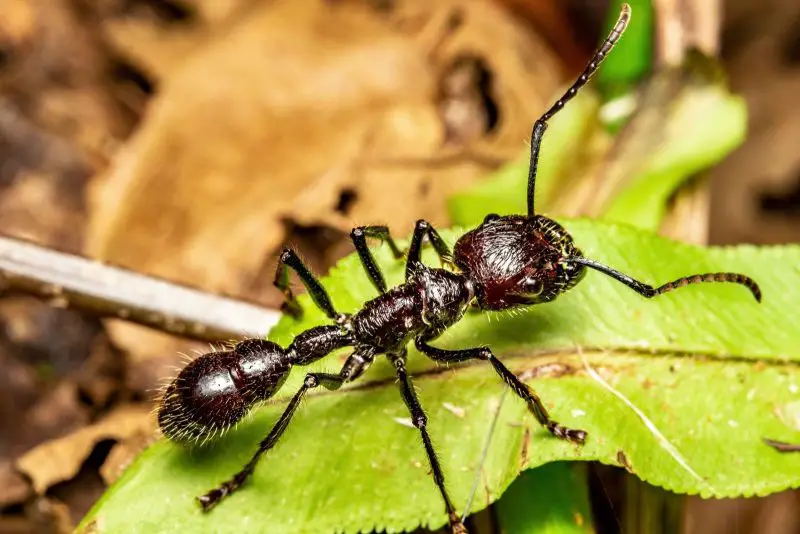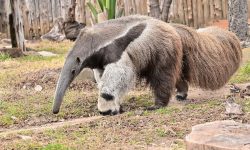Deep within the rainforests of Central and South America roams an insect feared not for its size, but for the searing agony of its sting. Paraponera clavata, commonly known as the bullet ant, is infamous for delivering the most painful insect sting ever recorded. It doesn’t just hurt—it overwhelms the senses, earning this ant a near-mythical reputation in both scientific literature and tribal lore.

What Is the Bullet Ant?
Taxonomy and Geographic Range
Paraponera clavata, commonly known as the bullet ant, is a member of the subfamily Paraponerinae within the family Formicidae. Remarkably, it is the sole species in the genus Paraponera, making it an evolutionary outlier with few close relatives. Its taxonomic isolation highlights its unique biological traits and specialized adaptations.
Geographically, bullet ants are native to lowland tropical rainforests spanning Central and South America. Their distribution ranges from eastern Honduras through Nicaragua, Costa Rica, and Panama, extending deep into northern Brazil, eastern Peru, Colombia, and Ecuador. Within these habitats, they show a preference for humid, shaded environments, particularly in primary rainforest ecosystems. Colonies typically nest at the base of large trees or beneath buttressed roots, with workers foraging high into the canopy along established pheromone trails.
Distinctive Physical Characteristics
Towering over most of their ant relatives, bullet ants are among the largest ant species in the world, with adult workers measuring up to 3 centimeters (1.2 inches) in length. Their imposing size is matched by a robust, reddish-black exoskeleton, which provides both camouflage among the forest floor detritus and protection against physical trauma.
The bullet ant’s mandibles are powerful, serrated tools used for gripping prey, manipulating leaves, and defending the colony. However, the feature that earns this species its global infamy lies at the posterior: a formidable stinger, evolved not just for defense but as a delivery system for one of the most painful neurotoxins in the animal kingdom.
Despite their intimidating appearance, bullet ants are not naturally aggressive toward humans unless provoked or their nests are disturbed. When threatened, however, they do not hesitate to unleash the full force of their biochemical arsenal, ensuring their place among nature’s most formidable insects.
The Bullet Ant Sting: Nature’s Most Excruciating Weapon
A Sting That Feels Like Fire
Few natural experiences rival the pain of a bullet ant sting. Ranked at the apex of the Schmidt Sting Pain Index, Paraponera clavata’s sting is a physiological event of pure agony. This index, which classifies insect stings on a scale from 1 to 4, reserves the elusive level 4+ solely for the bullet ant. Renowned entomologist Justin O. Schmidt described it as “pure, intense, brilliant pain. Like walking over flaming charcoal with a 3-inch nail embedded in your heel.”
The sting’s effects are immediate and dramatic. Victims typically experience:
- Blinding, searing pain at the puncture site
- Intense burning and radiating throbs across the limb
- Temporary paralysis or numbing sensations
- Prolonged symptoms that can persist for 12 to 24 hours, sometimes longer
Unlike the venom of bees or wasps, bullet ant venom is chemically unique. It contains a potent neurotoxic peptide known as poneratoxin, which targets voltage-gated sodium channels in nerve cells. This interference amplifies and sustains pain signals, triggering involuntary muscle spasms and systemic effects. It’s not just the intensity of the pain that’s extraordinary—it’s the duration and complexity of the body’s response.
Why Evolution Favored Such Extreme Pain
Why would evolution design such an excruciating sting? The answer lies in the bullet ant’s ecological vulnerability. Nesting at ground level and foraging visibly on trees, bullet ants are exposed to a range of predators, from mammals to birds. Their sting acts as a highly effective defensive mechanism, a deterrent so extreme that any animal lucky enough to survive one encounter is unlikely to risk another.
The sting is not meant to kill; it’s meant to teach a painful lesson. The evolutionary strategy is clear: inflict enough pain to be unforgettable. And in this, the bullet ant succeeds like no other.
As a result, Paraponera clavata has become a model species in the study of pain biology and chemical ecology, offering insights not only into insect defense mechanisms but also into the molecular pathways of nociception and nerve signaling.
Tribal Rituals and Cultural Significance
The Sateré-Mawé Glove Ceremony
In the dense rainforests of the Brazilian Amazon, the Sateré-Mawé people have developed one of the most intense and revered initiation rites in the world—one that revolves entirely around the bullet ant. As part of a coming-of-age ceremony, young boys seeking to prove their courage and endurance must place their hands into woven gloves filled with live, stinging bullet ants.
Each glove may contain dozens of ants, carefully sedated before being sewn into the glove with their stingers facing inward. Once awakened, the ants deliver repeated stings to the hands and arms of the participant for up to 10 minutes per trial. And this grueling test is not a one-time event—it must be endured up to 20 times over several months to complete the rite of passage into manhood.
The pain is unimaginable, often leaving the hands swollen, trembling, and temporarily paralyzed. Yet the boys must remain stoic and silent, enduring without screaming or withdrawing. The ritual is not merely physical—it is profoundly symbolic, designed to cultivate discipline, psychological resilience, and social identity within the tribe.
This extraordinary tradition illustrates the deep cultural significance of Paraponera clavata. Far beyond being a jungle menace, the bullet ant is transformed into a sacred instrument of transformation—a spiritual teacher through pain. Through it, generations are forged, bravery is defined, and a connection to ancestral values is preserved through a trial few outsiders can comprehend.
Behavior and Ecology
Social Structure and Nesting
Bullet ants are eusocial insects, meaning they live in structured colonies with a division of labor and cooperative brood care. Each colony is headed by a single reproductive queen, while hundreds of sterile worker ants perform tasks ranging from foraging to nest defense.
Nests are most often found at the base of large tropical trees, nestled in leaf litter, soil crevices, or beneath fallen logs. These subterranean and partially arboreal nests support intricate tunnel systems that link to surface foraging routes, often visible as trails of ants marching up tree trunks and along branches.
Foraging behavior is primarily nocturnal or crepuscular, although daytime activity is not uncommon. Workers gather nectar, sap, and arthropods, relying on their keen sense of smell and trail pheromones to navigate between food sources and the nest. Although generally non-aggressive when foraging, bullet ants are extremely defensive near their nests and readily deploy their sting in response to perceived threats.
Role in the Ecosystem
As both predators and prey, bullet ants serve an integral ecological role in tropical forests. Their predation on arthropods helps regulate populations of other insects, particularly soft-bodied invertebrates. In turn, they are preyed upon by a variety of forest inhabitants including birds, amphibians, and parasitic phorid flies.
Additionally, bullet ants contribute to seed dispersal and nutrient cycling through their foraging and nest-building behaviors. Their aggressive defense mechanisms also shape the behavior of other species, effectively influencing territory usage within the microhabitats they occupy.
In this complex web of interactions, Paraponera clavata stands out not just for its sting, but for its quiet yet crucial participation in maintaining the balance of one of the world’s most diverse ecosystems.
Pain With a Purpose
The sting of the bullet ant is not a quirk of evolution—it is a precision-crafted weapon forged by natural selection. Designed to inflict unforgettable agony, it serves as a powerful deterrent against predators and intruders alike.
But beyond the sting lies a deeper truth: Paraponera clavata is a marvel of ecological design, cultural symbolism, and biological resilience. Its venom inspires scientific inquiry. Its rituals shape tribal identity. And its presence reminds us that even in the smallest creatures, nature can wield unimaginable power.
In the tangled forests of the Amazon, the bullet ant endures—not just as a bearer of pain, but as a creature of profound purpose and awe-inspiring adaptation.
Final Thoughts
There are few insects that inspire awe and fear quite like the bullet ant. Through a single sting, it has captured the attention of biologists, survivalists, and tribal communities for generations. As our understanding of insect neurotoxins and pain deepens, so too does our respect for the sophisticated, high-stakes world of Paraponera clavata.
If pain has a face in the insect kingdom, it belongs to the bullet ant—and that sting is unforgettable.






